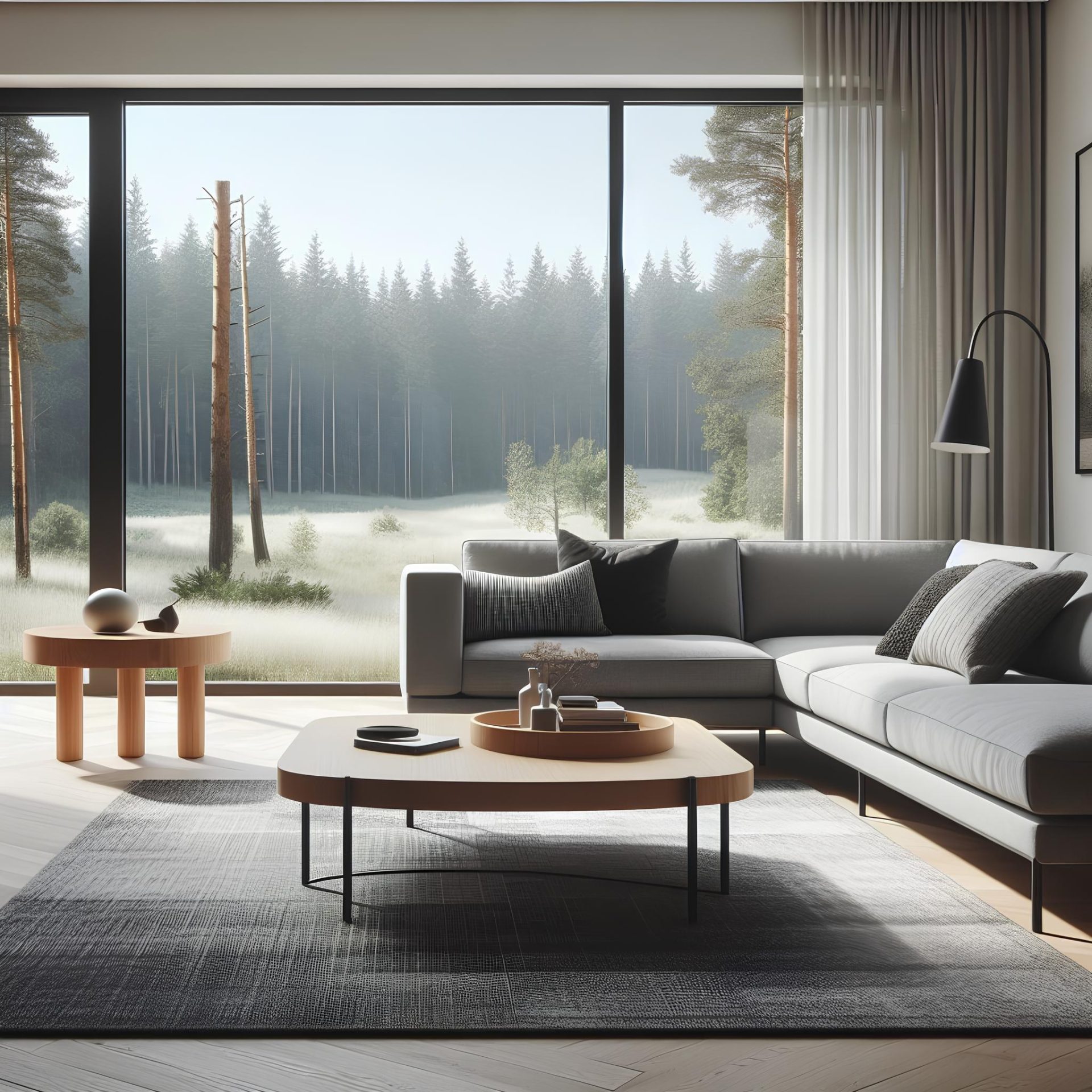The allure of minimalist living lies in its promise of simplicity and liberation. However, the journey towards a minimalist life is more than just a hurried act of discarding items. It’s a transformation that demands dedication and a series of mindful steps. This comprehensive guide offers actionable strategies to assist you in decluttering both your physical surroundings and mental space, thereby paving the way for a rewarding and purposeful minimalist lifestyle.
Why Minimalism? Understanding the Benefits
The perks of adopting a minimalist lifestyle go beyond the confines of a neat living space. Embracing this lifestyle can lead to holistic improvements in your wellbeing.
Achieving Mental Clarity with Minimalism
When you choose to live a minimalist life, you’re not just decluttering your physical space, but also your mental space. The process of decluttering is therapeutic and helps eliminate distractions that might be hindering your productivity. With fewer belongings demanding your attention, you can focus on your objectives and interests. This newfound focus can lead to increased productivity and satisfaction in your personal and professional life.
Reducing Stress
The minimalist lifestyle is a powerful tool for stress reduction. By owning fewer items, you have less to clean, less to maintain, and less to worry about. This reduction in physical clutter often leads to a reduction in mental clutter as well. The simplicity and order that minimalism brings to your physical environment can have a calming effect, reducing anxiety and making your home a more peaceful, relaxing place.
Financial Freedom
Adopting a minimalist lifestyle can have significant financial benefits. By making mindful purchasing decisions, you free yourself from the cycle of consumerism. When your shopping and spending habits align with your actual needs and values, you’ll find that you save money. This financial freedom can open up new opportunities and bring you closer to your financial goals.
A Gateway to Time and Energy
Minimalism is about more than just physical possessions; it’s about minimizing commitments and activities too. By simplifying your life, you free up time and energy that can be spent on activities that truly matter to you. Instead of wasting time on chores and obligations that bring you little joy, you can invest your time in activities that replenish your energy and bring you happiness.
Personal Growth
Minimalism can also lead to significant personal growth. By distinguishing between needs and wants, you cultivate mindfulness and become more aware of your consumption habits. This awareness can lead to a greater appreciation for the possessions you do have, promoting a sense of gratitude. As you continue on your minimalist journey, you’ll likely find that you’re not only decluttering your home, but also evolving as a person.
Mobility and Flexibility
One of the often-overlooked benefits of minimalism is increased mobility and flexibility. When you own fewer possessions, it’s easier to move and take advantage of new opportunities, whether that’s a job in a new city or a long-term trip around the world. By removing the physical anchors that tie you down, you open up a world of possibilities.
Decluttering Your Home: Where to Begin
Embarking on a decluttering journey can indeed seem overwhelming. Here’s a more detailed, room-by-room guide to help you methodically pare down and maintain a minimalist home.
Kitchen
- Utensils and Cookware: Keep only the utensils and cookware that you use regularly. If you have multiple items serving the same purpose, keep the best one and donate the rest. For example, if you have several frying pans but only use one or two, it’s time to let the others go.
- Appliances: Evaluate your kitchen appliances. If you haven’t used that bread maker or ice cream machine in the past year, it’s probably time to donate it.
- Food Storage: Go through your pantry and refrigerator. Dispose of expired items and donate non-perishable food that you won’t use.
- Dining Ware: Consider reducing your dining ware to a set number per family member. This not only reduces clutter but also makes dishwashing more manageable.
- Countertop: Keep your countertop as clear as possible. Store appliances that are not used daily in cabinets.
Living Room
- Furniture: Evaluate your furniture. If you have extra chairs that no one sits in or side tables that don’t serve a purpose, consider donating them.
- Decor: Keep only the decor items that you love and that add value to your space. If you have items that are just collecting dust, it’s time to let them go.
- Media: Go through your books, DVDs, and games. Donate any that you won’t revisit.
- Electronics: Evaluate your electronics. If you have multiple devices for the same purpose, consider keeping the one you use most and selling or donating the others.
- Rugs and Curtains: These can accumulate dust and make a room feel cluttered. Consider minimal and easy-to-clean options.
Bedrooms
- Clothing: Go through your clothing item by item. Donate anything that doesn’t fit, that you don’t love, or that you haven’t worn in the past year.
- Bedding: You really only need two sets of bedding: one to use while the other is in the wash. If you have more than this, consider donating the extras.
- Furniture: If you have extra furniture in your bedroom that serves little purpose, such as a chair that’s always piled with clothes, consider getting rid of it.
- Personal Items: Keep personal items to a minimum. Too many items can make a room feel cluttered and disorganized.
- Lighting: Opt for minimalist lighting options. This can help create a calm and peaceful atmosphere.
Bathrooms
- Toiletries: Go through all your toiletries and cosmetics. Dispose of any that are expired or that you don’t use.
- Towels: Pare down to two sets of towels per person: one to use while the other is in the wash.
- Medicine Cabinet: Dispose of expired medications and any that you no longer need.
- Cleaning Supplies: Keep only what you need. Too many products can create unnecessary clutter.
- Shower/Bath Area: Keep this area as clear as possible. Use a shower caddy to organize your bath products.
Garage and Storage Spaces
- Tools: Keep only the tools that you use regularly. If you have duplicates, keep the best one and donate the rest.
- Seasonal Items: Go through your seasonal items at the end of each season. Donate anything that you didn’t use that season.
- Storage Boxes: If you have boxes that you haven’t opened since your last move, it’s probably time to go through them and donate anything you don’t need.
- Vehicles: If you have vehicles that you rarely use, consider selling them. This can free up a lot of space in your garage.
- Workbench: If you have a workbench, keep it as clear as possible. This makes it easier to work on projects and keeps your tools organized.
Streamlining Your Closet
Your wardrobe is a crucial area of focus in your minimalist journey as it can quickly become a source of clutter. Here’s a more comprehensive look at how to effectively declutter your closet.
Remove Items That Don’t Fit
Clothes that no longer fit can negatively impact your self-esteem. Make a conscious decision to let go of these items, creating room for clothing that makes you feel confident and comfortable.
Evaluate Worn or Damaged Pieces
Discard stained, torn, or threadbare garments that are beyond repair. If items are gently used and still wearable, consider donating them. Adopting a quality over quantity mindset can significantly streamline your closet.
Assess How Often You Wear Pieces
If you haven’t worn an item in over a year, it’s time to let it go. The same applies to occasion-specific items that you rarely use. Aim to pare down your wardrobe to essential pieces that you regularly wear and love.
Sort by Season
Designate space in your closet for current season clothing only. Pack away out-of-season apparel and store it elsewhere. Rotate these items as the seasons change to keep your closet organized and manageable.
Adopt a Capsule Wardrobe
Consider building a curated capsule wardrobe consisting of versatile staples that can be mixed and matched seamlessly. Limit yourself to 25-30 essential pieces per season to maintain simplicity.
Remember, your wardrobe should make you feel amazing. Identify the items that enhance your best self and let go of the rest.
Rent clothes
Incorporating the practice of renting clothes into your lifestyle can be a powerful step towards minimalism. It aligns perfectly with the minimalist ethos of reducing excess and only keeping what is truly necessary and valuable. By renting clothes, you maintain a lean, functional wardrobe, free from clutter and unused items. This approach not only simplifies your closet but also your daily decision-making process, as you’re no longer overwhelmed by unnecessary choices.
Moreover, renting clothes is a sustainable fashion practice. It counters the fast-fashion culture, which is known for its high waste and environmental impact. By reusing and sharing resources, we reduce the demand for new production, thus conserving resources and reducing waste. So, renting clothes is not just a minimalist choice, but also an environmentally conscious one. It’s a practice that allows us to look great, keep our lives clutter-free, and contribute to the health of our planet.
Decluttering Your Digital Life
Minimalism extends beyond physical possessions. It’s equally important to apply its principles to your digital life:
Clean Up Devices: Optimize for Efficiency
Delete apps you never use and downloads you don’t need. Organize your documents and photos into specific folders for easy access. Regularly delete unnecessary files to keep your devices running smoothly.
Unsubscribe from Emails
Take control of your inbox by unsubscribing from emails that you no longer find useful. Opt-in only to emails you truly want to receive and manage the rest via search to prevent inbox clutter.
Pare Down Social Media: Cultivate a Positive Online Environment
Unfollow accounts that trigger negative emotions such as comparison, jealousy, or irritation. Trim your friends list to those you genuinely care about. Limit your time on social media apps and websites to maintain a healthy digital life balance.
Store Photos and Videos: Preserve Memories, Save Space
Back-up your photos and videos on an external drive or cloud storage. Then, delete blurry images and duplicates from your devices to save space and keep your photo library organized.
Simplify Your Financial Life
Cancel unused subscriptions and memberships to save money. Organize your financial documents digitally via scanning or online storage for easy access and better financial management.
Embrace digital minimalism to free your devices and online spaces of digital debris that weighs you down. This will lead to a more organized, efficient, and stress-free digital life.
Cultivating Mindful Consumption Habits
Living minimally necessitates rethinking your buying habits. Here are tips:
Needs vs. Wants
Pause before any purchase and reflect on whether this item fulfills a true need or merely a fleeting want. Be rigorously honest with yourself. Delay gratification by giving yourself 24 hours to reconsider wants. Create a monthly “needs” budget as a spending limit.
Invest in Quality
Minimalism favors quality over quantity. Seek out well-crafted items built to last through years of use. Research brands known for durability and craftsmanship. Be willing to spend more upfront if it means purchasing something only once rather than its cheaper disposable counterpart again and again.
Seek Multifunctional Items
Opt for items serving multiple purposes rather than single-use things occupying your space. Choose furniture and tools with customizable features over niche specialty items. Seek hidden potential – could that storage ottoman also hold extra blankets? Can you prepare several recipes using that one appliance?
Buy Secondhand First
Before buying new, browse consignment shops or used retailers like Craigslist for quality pre-owned items. Search by brand names you trust for lightly used goods at discount prices. Vintage shops offer unique finds.
Spend on Experiences
Invest discretionary money into experiences creating lasting memories rather than material objects generating clutter. Share meals with loved ones, take a pottery class, learn rock climbing, enroll in language lessons – choose adventure over stuff.
Mindful consumption prevents minimalism backsliding. Make purchases deliberately.
Sustaining a Minimalist Lifestyle
Maintaining a minimalist lifestyle requires constant vigilance and the development of habits that become second nature. Here’s a more in-depth look at these habits.
Regular Reassessment
Incorporate regular reassessments into your routine. Set reminders on your calendar to periodically go through your space and remove items that no longer serve a purpose. This could be done seasonally for clothing and annually for kitchen tools and decor. This practice ensures that you’re not accumulating unnecessary items and helps keep your space decluttered.
Adopt a Rotation System
Consider adopting a rotation system for your items. This involves rotating items in and out of use so you’re not overwhelmed by excess all at once. For instance, you could switch out throw pillows or display artwork seasonally. If you have children, consider rotating toys, keeping some in storage to bring out later so they feel “new”. This system can help keep your space fresh and interesting without adding clutter.
Establish Accountability
Find a minimalism buddy. This could be a friend or family member who is also interested in minimalist living. Regularly check in with each other on your decluttering progress for motivation and support. They can also provide an outside perspective and question new purchases, helping you stay mindful of your consumption habits.
Schedule Deep Cleans
Don’t just tidy – deep clean your home frequently. This involves thoroughly cleaning each room and organizing and decluttering in the process. Scheduling these deep cleans ensures that they don’t get postponed and helps maintain a clean and organized home.
Donate Promptly
Don’t let items destined for donation clutter your space. Keep donation bags or boxes ready and load up your car with items to donate on a regular basis, such as monthly. This habit ensures that items you no longer need are promptly removed from your space.
With vigilance and these habits, minimalism becomes a sustainable lifestyle. Regularly reassess, reflect, and declutter to maintain this fulfilling way of life.
Overcoming Obstacles to Minimalist Living
Adopting minimalism has hurdles. Being aware of them allows you to leap over them.
Perfection Pitfall
Don’t get derailed striving for an impossibly perfect, clutter-free home. Progress over perfection. Focus on small, sustainable improvements rather than complete overhaul. Establish realistic milestones and build decluttering into your routine gradually. As long as you’re moving forward, perfection doesn’t matter.
Comparison Conundrum
Don’t worry about what decluttering or minimalism looks like for others. Social media highlights reel versions aren’t reality. Focus on your own needs, values and vision when minimizing. Start with your space, schedule and real-life demands rather than imposing someone else’s approach.
Sentimental Struggles
Letting go of sentimental items is difficult. Take time to process these emotions rather than force-dumping beloved possessions. Reflect on the memories they represent, take photos, then reflect on whether retaining objects is necessary for honoring those experiences. For highly sentimental items, consider repurposing in a way imbuing new meaning over time such as making a memory quilt. Cherish memories without being chained to objects.
Motivation Maintenance
Maintaining minimalist motivation is challenging as enthusiasm wanes. Counteract this by regularly reminding yourself why you started. Revisit old vision boards or journal entries detailing your sparks of inspiration. Share your journey with others to reinforce commitment. When motivation lags, recenter yourself in the lifestyle’s benefits for renewed energy.
Occasional Overindulgences
Go easy on yourself when you occasionally overspend or accumulate more than intended. Slip-ups are part of the journey rather than reasons to surrender. Analyze what need the overindulgence aimed to meet and address it more mindfully. Then rediscover your motivation and get back on track without self-shaming. Remember progress isn’t linear.
Stay focused on the big picture benefits. Don’t let stumbles become excuses to abandon the minimalist path altogether. Each day is a chance to renew commitment.
Minimalism for Fulfillment
At its core, minimalism simply clears space for what gives your life meaning. It removes clutter so relationships, growth, passions and purpose can thrive and be nurtured. Allow yourself to let go of the superfluous so you can invest in the extraordinary.
Final Thoughts on Minimalist Living
Embarking on the journey towards minimalist living requires introspection, visualizing your desired lifestyle, and gradually developing new habits. This profound simplification liberates you from the distracting pull of clutter, allowing you to gravitate towards a life of intentionality.
The process of decluttering is not limited to your physical space but extends to your mind and daily routines. By reducing your possessions, you amplify fulfillment that is deeply rooted in what you truly value. This is not an overnight transformation but a gradual shift that unfolds over time.
The minimalist lifestyle is not about having less but about making room for more: more time, more peace, and more freedom. It’s about removing the things that distract us from what’s truly important, enabling us to live a life that’s rich in experiences, relationships, and meaningful activities.
So, as you step into this journey of minimalist living, remember that it’s not about reaching a destination, but about embracing a new way of life. A life that is less cluttered, less stressful, and more meaningful. A life where less is indeed more.



